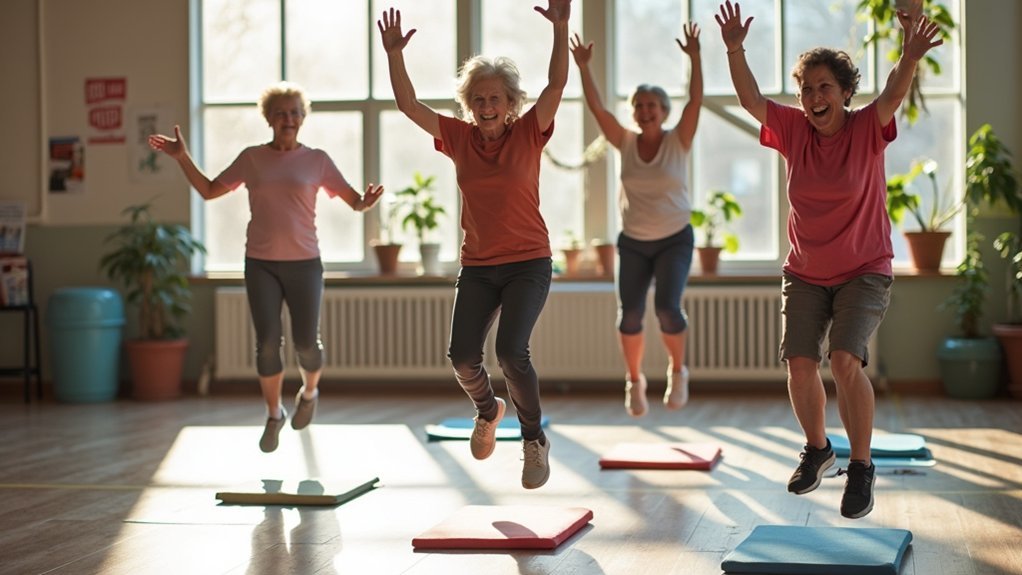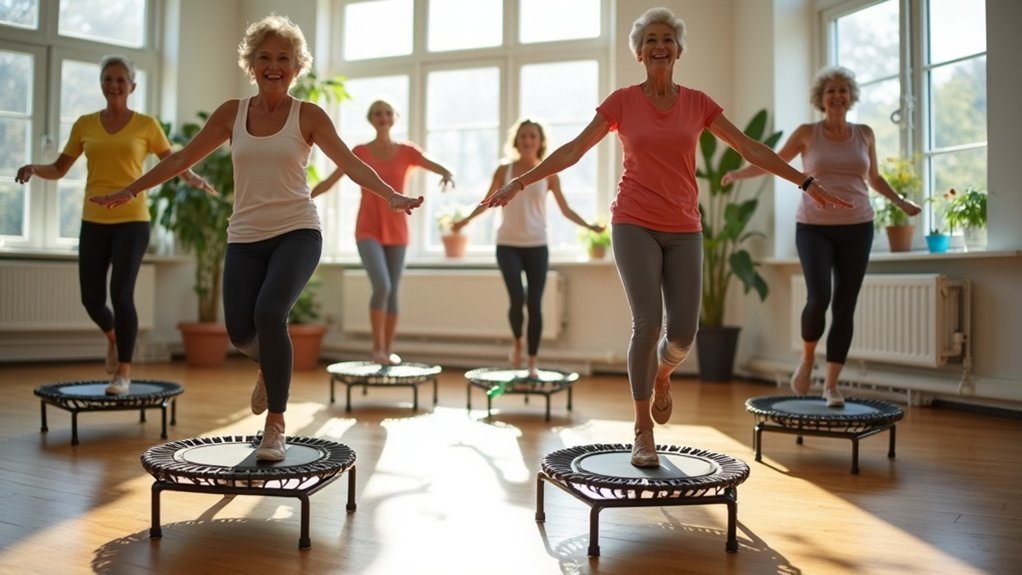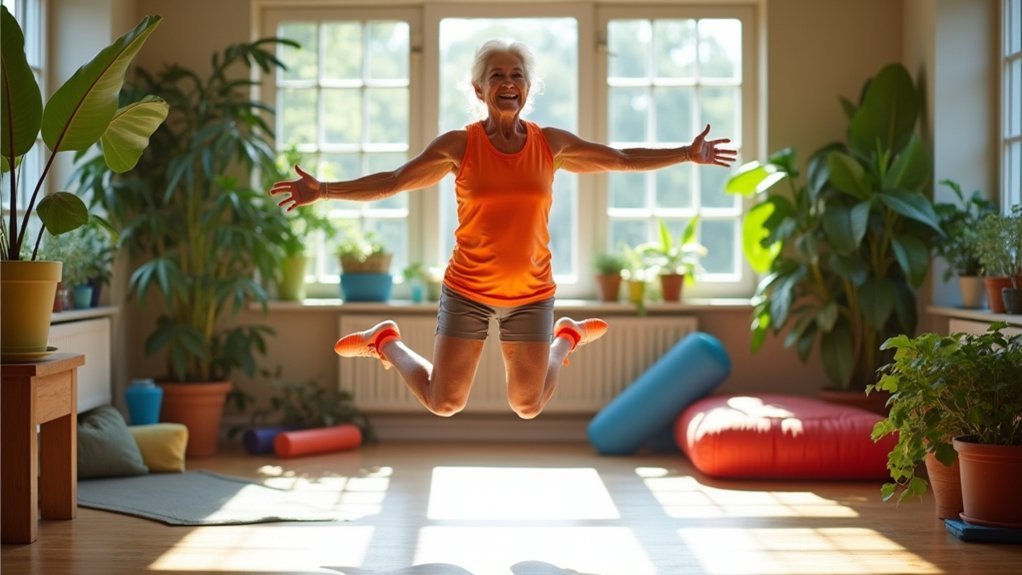Mini jumping workouts on trampolines offer seniors powerful balance benefits with minimal joint impact. You’ll strengthen core muscles, improve stability, and reduce fall risk while enjoying a mood-boosting activity. Start with simple bounces while holding a handlebar, then progress to dynamic movements like leg swings as your confidence grows. Always warm up first and consult your healthcare provider before beginning. The journey to better balance begins with just 15 minutes daily.
Ageless Balance: Mini Jumping Workouts for Seniors

While many seniors might shy away from jumping exercises, mini jumping workouts offer remarkable benefits for balance and stability as you age. These dynamic movements engage your core muscles and improve proprioception, which is essential for preventing falls.
Start with a gentle warm-up of modified jumping jacks to elevate your heart rate and prepare your body for more targeted exercises.
Then, practice balancing on one foot while using a trampoline surface for added support. This challenges your stabilizing muscles while providing a safe environment for practice.
Try holding static poses like Tree Pose for 5-10 seconds, gradually increasing duration as you gain confidence.
These exercises not only enhance your balance but also improve flexibility and strength, contributing to greater independence in daily activities.
The Science Behind Trampoline Exercises for Seniors
Because traditional high-impact exercises can strain aging joints, trampoline workouts have emerged as a scientifically-backed alternative for seniors seeking fitness benefits without the pain.
Research confirms that these low-impact exercises markedly reduce joint strain while improving cardiovascular health.
When you perform a gentle knee raise on a mini-trampoline, you’re engaging multiple systems that support healthy aging:
- Your proprioception improves, enhancing balance and reducing fall risk
- Core muscles activate with each bounce, supporting better posture
- Your body releases mood-enhancing hormones, combating anxiety and depression
The rebounding motion strengthens lower body muscles essential for daily mobility while protecting your joints.
This makes mini-trampoline workouts particularly valuable if you’re managing arthritis or seeking to maintain independence through improved balance and strength.
Getting Started: Essential Safety Guidelines

Before enjoying the incredible benefits of trampoline workouts, you’ll need to establish proper safety measures to protect yourself during exercise. Consult your healthcare provider first to ascertain mini-trampoline workouts align with your specific health needs.
Choose a trampoline with a sturdy handlebar and non-slip surface to enhance your balance and prevent falls. When starting, keep one foot on the ground while practicing basic movements to build confidence and stability.
Begin each session with gentle warm-up activities that gradually increase your heart rate. Having a spotter or sturdy chair nearby provides additional safety during balance exercises.
Most importantly, listen to your body. If you feel pain or excessive fatigue, take a break. Your comfort and safety should always be your priority during these workouts.
Warming Up Your Body for Rebounding Success
After ensuring all safety measures are in place, you’ll need to properly prepare your body for the dynamic movements of rebounding.
Begin with 5-10 minutes of gentle bouncing to activate your stabilizing muscles and enhance your balance. Hold the handlebar with a light grip during this warm-up phase to maintain stability.
Embrace gentle bouncing as your gateway to stability, activating key muscles while maintaining a light grip for optimal balance.
For an effective rebounding preparation, follow these key steps:
- Start with press bounces if you need to keep your feet on the trampoline.
- Progress to side to side movements to engage your core muscles.
- Shift into Cross Country skiing motions to warm up your thighs and hamstrings.
Consistent warm-up routines improve your flexibility and balance over time, creating a solid foundation for your mini jumping workouts and maximizing your rebounding success.
Foundational Balance Techniques on Mini Trampolines

Begin your balance journey by practicing static holds on your mini trampoline, simply standing tall with feet hip-width apart to build core strength and stability.
You’ll notice immediate engagement of small stabilizing muscles that don’t activate as intensely on solid ground.
As you gain confidence, challenge yourself by shifting weight between feet or closing your eyes to increase difficulty and further enhance your proprioceptive awareness.
Static Holds Matter
The foundation of mini trampoline success for seniors lies in mastering static holds. These balance exercises improve your proprioception and stability when practiced regularly on the trampoline’s unstable surface. Maintaining poses like the Tree Pose for 5-10 seconds challenges your body to find its center while strengthening your core.
To maximize benefits from static holds:
- Perform 3-4 repetitions on each leg
- Modify poses to match your ability (foot at calf or knee)
- Focus on proper posture throughout each hold
As you practice these exercises, you’ll notice improved balance and reduced fall risk. The trampoline’s unique surface creates an ideal environment for developing stability, encouraging proper alignment and enhancing your body awareness.
With consistent practice, you’ll build the strength necessary for confident, independent movement.
Surface Challenges Progress
While static holds build your foundation, progressing to surface challenges on your mini trampoline greatly enhances your balance capabilities. The dynamic surface engages your stabilizing muscles more intensely than solid ground, improving coordination as you practice foundational techniques.
Try standing on one leg while performing gentle leg lifts or swings. The trampoline’s slight instability helps train your body to find its center more effectively. Even traditional poses like Tree Pose become more beneficial when performed on this responsive surface.
Don’t worry if you’re just starting—modifications are readily available. Begin with simpler static positions while holding onto a chair for support, then gradually reduce assistance as your confidence grows.
As your balance improves, you’ll notice enhanced core strength and posture—crucial elements for maintaining mobility and reducing fall risks.
Tree Pose Variations for Enhanced Stability
Improving your stability becomes increasingly important as you age, and Tree Pose offers an excellent way to strengthen balance while engaging core muscles.
This yoga-inspired exercise can be adapted to your comfort level while still challenging your stability on the mini trampoline.
Try these progressive variations:
- Beginner Level: Place your foot against your calf while holding the handlebar for support.
- Intermediate Level: Position your foot against your inner thigh and practice holding for 5-10 seconds.
- Advanced Level: Release the handlebar completely while maintaining the pose.
The unstable trampoline surface intensifies the balance challenge, developing proprioception and coordination more effectively than on solid ground.
Practice 3-4 repetitions on each leg to build confidence and strengthen the stabilizing muscles that prevent falls.
Leg Lift Exercises to Strengthen Core and Lower Body
As your body ages, maintaining lower body strength becomes essential for everyday mobility and independence. Leg lifts provide an excellent way to build core strength while improving stability. When you practice these exercises on a mini trampoline, you’ll enhance your proprioception and balance training effectiveness.
| Exercise Type | Muscle Target | Balance Benefit |
|---|---|---|
| Front Knee Raises | Core & Hip Flexors | Improves Forward Stability |
| Lateral Leg Lifts | Hip Abductors | Enhances Side Stability |
| Back Leg Extensions | Glutes & Lower Back | Strengthens Posterior Chain |
Keep your spine strong and aligned during all leg lifts to prevent injury. Try incorporating Warrior 3 poses to challenge your balance further while strengthening different muscle groups. With consistent practice, you’ll notice improved core strength, better stability in daily activities, and reduced fall risk.
Handlebar Support Methods for Progressive Independence
Safety and confidence form the foundation of any effective senior exercise program. Your mini trampoline’s handlebar offers essential support as you develop balance skills, gradually building toward greater independence.
By starting with handlebar support during balance exercises, you’ll gain the stability needed to progress safely.
Try these handlebar techniques to build confidence:
- Full Support – Begin with both hands firmly gripping the bar during all movements.
- Partial Support – Advance to using just fingertips or one hand for lighter assistance.
- Touch-and-Go – Practice briefly releasing the handlebar during stable moments.
As you practice regularly, you’ll notice improved proprioception and muscle control.
Varying your hand positions engages different muscle groups, enhancing overall stability while reducing fall risk and promoting an active lifestyle.
Dynamic Swing Movements for Hip Mobility
Hip mobility often declines with age, making dynamic swing movements on your mini trampoline particularly valuable for maintaining functional independence.
Try incorporating lateral and front-to-back leg swings to promote full range of motion in your hip joints while enjoying the trampoline’s low-impact benefits.
Hold the handlebar for stability as you practice these movements, which helps build confidence and balance as you coordinate each swing.
Keep a soft bend in your supporting leg to absorb impact and strengthen the stabilizing muscles around your hips.
With consistent practice, these dynamic swing movements will improve your hip mobility, enhance your balance, and increase functional strength—essential components for everyday activities.
The trampoline’s forgiving surface minimizes joint stress while effectively targeting the muscles that support hip function.
Adapting Exercises for Different Mobility Levels
When adapting trampoline exercises for seniors, you’ll need to modify movements based on individual stability needs, such as starting with press bounces while keeping feet grounded.
You can incorporate progression by using the trampoline’s handlebar for support during challenging movements like swing exercises or balance poses.
Remember to encourage participants to adjust each exercise according to their comfort level, allowing them to safely build strength and confidence at their own pace.
Modify for Stability
Although jumping exercises offer excellent benefits for seniors, adapting them properly guarantees everyone can participate safely regardless of mobility level.
When you modify for stability, focus on making adjustments that maintain confidence while building strength. Make sure to offer options that support balance challenges without sacrificing the workout’s effectiveness.
Try these stability-focused modifications:
- Use the handlebar during leg lifts and swings, keeping one hand (or both) on for support while performing movements.
- Maintain a soft bend in your standing leg to absorb work and create a more stable foundation.
- Adapt balance poses by lowering your foot to the ground on one side if traditional positions feel too challenging.
Progression Through Support
Success in mini trampoline workouts depends largely on finding the right level of support for your specific needs.
Begin with trampoline exercises that allow you to maintain a light grip on the handlebar, ensuring safety while building confidence in your movements.
As your stability improves, gradually decrease your reliance on balance support.
Try static poses like the Tree Pose, adjusting foot placement to your ankle or calf based on your comfort level.
For those with mobility challenges, incorporate lower-impact options such as press bounces or modified jumping jacks with feet remaining on the mat.
Challenge yourself appropriately by holding poses longer or occasionally removing hands from the handlebar.
The trampoline’s surface provides an ideal environment for dynamic leg lifts and gentle swings while you adjust support as needed.
Building a 15-Minute Daily Balance Routine
Fifteen minutes a day is all you’ll need to transform your stability and confidence with this carefully designed balance routine.
Begin with a warm-up of gentle trampoline bouncing and modified jumping jacks to prepare your muscles for the balance exercises ahead.
Proper warm-up activates your balance systems and primes your body for stability work – never skip this essential first step.
Move into the core workout by practicing static poses like the Tree Pose, holding for 5-10 seconds with 3-4 repetitions on each leg to build stability.
Then challenge yourself with these trampoline variations:
- Gentle leg lifts to strengthen hip flexors
- Side leg swings to improve lateral stability
- Front-to-back leg movements for enhanced coordination
Finish with cool-down stretches including quad and chest openers to maintain flexibility.
This daily practice will considerably reduce fall risks while improving your mobility for everyday activities.
Tracking Your Balance Progress Over Time
Measuring your balance improvements provides powerful motivation to continue your jumping workouts. Start by timing how long you can hold static poses, gradually working from 5 to 10 seconds over several weeks. This concrete measurement clearly demonstrates your growing stability.
Record your progress in a journal or app, noting successful repetitions and your ability to shift from supported to independent balancing. Challenge yourself regularly with one-legged stands, tracking duration improvements week by week.
Don’t overlook qualitative progress—document how your comfort level changes during dynamic movements like leg swings. These observations reveal subtle improvements in your overall balance capabilities.
Frequently Asked Questions
Is Mini Trampoline Good Exercise for Seniors?
Yes, mini trampolines are excellent for you as a senior. They’ll give you low-impact cardio, improve your balance, strengthen core muscles, boost lymphatic circulation, and can be adapted to your personal fitness level.
What Is the Number 1 Exercise to Increase Balance in Seniors?
The Tree Pose is your #1 exercise to increase balance. You’ll improve stability by standing on one leg, placing your other foot against your ankle, calf, or thigh while maintaining proper posture.
Is Jumping Good Exercise for Seniors?
Yes, jumping can be good for you as a senior. When done safely with low-impact variations, it strengthens bones, improves balance, enhances coordination, and boosts your cardiovascular health without excessive joint strain.
How Often Should Seniors Do Balance Exercises?
You should practice balance exercises at least two to three times weekly for 20-30 minutes per session. This consistent routine can reduce fall risk by 30% while improving your mobility, strength, and confidence.
In Summary
You’ve now discovered how mini trampolines can transform your balance journey. Start with just five minutes daily and watch your confidence grow. Remember to honor your body’s limits while gently pushing boundaries. As you’ve learned, these small bouncing moments create significant stability improvements. Track your progress, celebrate small victories, and enjoy the gentle rhythm of rebounding—it’s not just exercise, it’s your path to lasting mobility and independence.





Leave a Reply